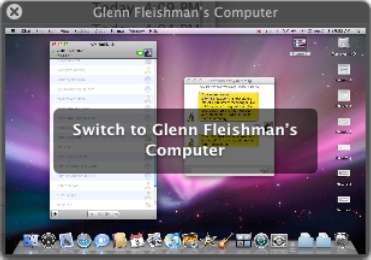With screen sharing started, things get interesting. What happens depends on your observer position: are you the controller or the one being controlled? In both cases, if both parties have an attached device that can take in sound, like a built-in or USB-attached microphone or a built-in or FireWire-attached iSight camera, an audio chat starts up at the same time.
Tip
When screen sharing via iChat, the contents of the Clipboard can't be transferred between the local and remote machines. To use the Clipboard, you must connect via the Screen Sharing program, meaning you must make a Bonjour, direct, or Back to My Mac connection.
If you are the controlling party, your screen changes to that of the remote computer (Figure 3-6). A small inset window—labeled My Computer—shows your screen at reduced size, but with a live display. Move the mouse around, and you're moving the pointer on the remote screen. You're in control! (Talk to your buddy; reassure her of your good intent.)
Figure 3-6. The screen you're sharing is shown large, while your own screen is embedded in a floating window labeled My Computer. If you have a camera or microphone active, you can share audio and video, too.
If you hover over the floating screen that's the tiny version of the computer you're physically working on, a banner appears on that inset that reads Switch to My Computer (Figure 3-7).
Figure 3-7. The small inset screen lets you click to swap your "live" computer's display for
the remote screen. The ![]() ends the current session when clicked.
ends the current session when clicked.
Click that and your screen is swapped for that of the remote screen. Now if you hover over the tiny inset of the remote screen the banner reads Switch to [Owner's Name]'s Computer; click that and the display swaps back to the remote screen (Figure 3-8).
Figure 3-8. Hover over the remote screen when it's shrunken, and you can click to restore it to full screen mode.
Note
X marks the stop!
That little
![]() in the inset screen's upper left isn't meant to hide the screen—rather,
clicking the X immediately halts the screen-sharing session!
in the inset screen's upper left isn't meant to hide the screen—rather,
clicking the X immediately halts the screen-sharing session!
With two or more monitors, an iChat screen-sharing session takes over just the main window—the window on which the system menu bar appears. If you use your mouse to click on something in another display, iChat swaps back to your computer being dominant and the remote system shown in a tiny window as in Hover Over the Remote Screen When It's Shrunken, and You Can Click to Restore It to Full Screen Mode, previous page.
If you're being controlled, your screen remains unchanged except that a menu appears on the menu bar. The menu lets you know that you're being controlled and lets you disconnect the remote party (Figure 3-9).




